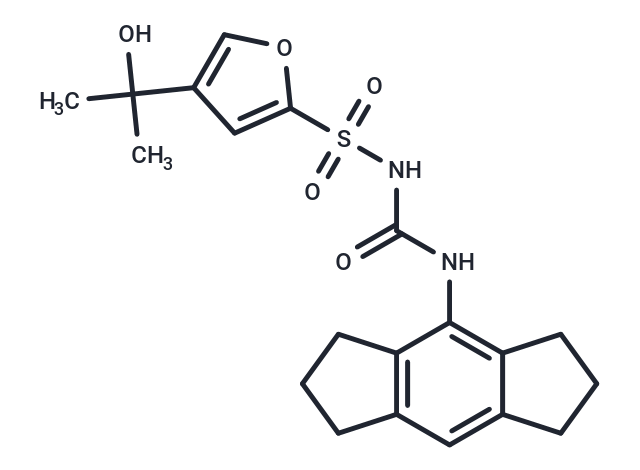Shopping Cart
- Remove All
 Your shopping cart is currently empty
Your shopping cart is currently empty

CP-456773 (MCC950 (CP-456773) and CRID3) is an effective and specific cytokine release inhibitor and NLRP3 inflammasome inhibitor. CP-456773 inhibits IL-1β secretion and caspase 1 processing. MCC950 blocked canonical and noncanonical NLRP3 activation at nanomolar concentrations. MCC950 specifically inhibited activation of NLRP3 but not the AIM2, NLRC4 or NLRP1 inflammasomes. MCC950 reduced IL-1β production in vivo and attenuated the severity of experimental autoimmune encephalomyelitis (EAE), a disease model of multiple sclerosis.

| Pack Size | Price | Availability | Quantity |
|---|---|---|---|
| 2 mg | $30 | In Stock | |
| 5 mg | $50 | In Stock | |
| 10 mg | $79 | In Stock | |
| 25 mg | $162 | In Stock | |
| 50 mg | $266 | In Stock | |
| 100 mg | $415 | In Stock | |
| 1 mL x 10 mM (in DMSO) | $55 | In Stock |
| Description | CP-456773 (MCC950 (CP-456773) and CRID3) is an effective and specific cytokine release inhibitor and NLRP3 inflammasome inhibitor. CP-456773 inhibits IL-1β secretion and caspase 1 processing. MCC950 blocked canonical and noncanonical NLRP3 activation at nanomolar concentrations. MCC950 specifically inhibited activation of NLRP3 but not the AIM2, NLRC4 or NLRP1 inflammasomes. MCC950 reduced IL-1β production in vivo and attenuated the severity of experimental autoimmune encephalomyelitis (EAE), a disease model of multiple sclerosis. |
| Targets&IC50 | BMDM:7.5nM, HMDM:8.1 nM |
| In vitro | MCC950 effectively inhibits both canonical and non-canonical NLRP3 activators at nanomolar concentrations, distinguishing its specificity towards NLRP3 inhibition while not affecting AIM2, NLRC4, or NLRP1 activations. Its impact on NLRP3 inflammasome activity was evaluated in both mouse bone marrow-derived macrophages (BMDM) and human monocyte-derived macrophages (HMDM), demonstrating similar IC50 values of approximately 7.5 nM and 8.1 nM, respectively. MCC950 selectively reduces IL-1β secretion without influencing TNF-α levels, and it uniquely prevents caspase-11-mediated NLRP3 and IL-1β activation in the non-canonical pathway. However, MCC950 does not suppress NLRC4-induced IL-1β and TNF-α secretion, even at concentrations up to 10 μM, and fails to block caspase-1 activation or IL-1β processing following Salmonella typhimurium exposure. Furthermore, MCC950 does not markedly alter the expression levels of pro-caspase-1 and pro-IL-1β in treated cell lysates[1]. |
| In vivo | MCC950 effectively lowers production of Interleukin-1β (IL-1β) and lessens the severity of experimental autoimmune encephalomyelitis (EAE), serving as a model for multiple sclerosis. It not only reduces serum levels of IL-1β and IL-6 without significantly affecting TNF-α concentrations but also delays the onset and diminishes the severity of EAE in treated mice. Furthermore, analysis through intracellular cytokine staining and FACS of brain mononuclear cells from mice euthanized on day 22 reveals that MCC950 treatment slightly decreases the prevalence of IL-17 and IFN-γ producing CD3+ T cells, in comparison to PBS-treated controls. Notably, the numbers of cells producing IFN-γ and especially IL-17 are lower in both CD4+ and γδ+ subsets of CD3+ T cells. |
| Kinase Assay | Disk diffusion is conducted, except that 10 μg of each antibiotic compound is used per filter. Growth in liquid medium in the presence of CHIR-090 is evaluated as follows: cells from overnight cultures are inoculated into 50 mL portions of LB broth at an A600 of 0.02 and grown with shaking at 30°C. When the A600 reaches 0.15, parallel cultures are treated with either 6 μL of 500 μg/mL CHIR-090 in DMSO or 6 μL of DMSO. To assess cumulative growth, cultures are maintained in log phase growth by 10-fold dilution into pre-warmed medium, containing the same concentrations of DMSO or DMSO/CHIR-090, whenever the A600 reaches 0.4. The minimal inhibitory concentration is defined as the lowest antibiotic concentration at which no measurable bacterial growth is observed in LB medium containing 1% DMSO (v/v), when inoculated at a starting density of A600=0.01. Cultures are incubated with shaking for 24 h at 30°C in the presence of CHIR-090. Experiments are performed in triplicate[1]. |
| Cell Research | MCC950 is dissolved in DMSO and stored, and then diluted with appropriate media before use[1]. BMDM are seeded at 5×105/mL or 1×106/mL, HMDM at 5×105/mL and PBMC at 2×106/mL or 5×106/mL in 96 well plates. The following day the overnight medium is replaced and cells are stimulated with 10 ng/mL LPS from Escherichia coli serotype EH100 (ra) TLRgrad for 3 h. Medium is removed and replaced with serum free medium (SFM) containing DMSO (1:1,000), MCC950 (0.001-10 μM), glyburide (200 μM), Parthenolide (10 μM) or Bayer cysteinyl leukotriene receptor antagonist 1-(5-carboxy-2{3-[4-(3-cyclohexylpropoxy)phenyl]propoxy}benzoyl)piperidine-4-carboxylic acid (40 μM) for 30 min. Cells are then stimulated with inflammasome activators: 5 mM adenosine 5'-triphosphate disodium salt hydrate (ATP) (1 h), 1 μg/mL Poly(deoxyadenylic-thymidylic) acid sodium salt (Poly dA:dT) transfected with Lipofectamine 200 (3-4 h), 200 μg/mL MSU (overnight) and 10 μM nigericin (1 h) or S. typhimurium UK-1 strain. Cells are also stimulated with 25 μg/mL Polyadenylic-polyuridylic acid (4 h). For non-canonical inflammasome activation cells are primed with 100 ng/mL Pam3CSK4 for 4 h, medium is removed and replaced with SFM containing DMSO or MCC950 and 2 μg/mL LPS is transfected using 0.25% FuGENE for 16 h. Supernatants are removed and analysed using ELISA kits. LDH release is measured using the CytoTox96 non-radioactive cytotoxicity assay[1]. |
| Alias | CP-456773 |
| Molecular Weight | 404.48 |
| Formula | C20H24N2O5S |
| Cas No. | 210826-40-7 |
| Smiles | CC(C)(O)c1coc(c1)S(=O)(=O)NC(=O)Nc1c2CCCc2cc2CCCc12 |
| Relative Density. | 1.396 g/cm3 (Predicted) |
| Storage | Powder: -20°C for 3 years | In solvent: -80°C for 1 year | Shipping with blue ice. | |||||||||||||||||||||||||||||||||||
| Solubility Information | DMSO: 83.33 mg/mL (206.02 mM), Sonication is recommended. | |||||||||||||||||||||||||||||||||||
Solution Preparation Table | ||||||||||||||||||||||||||||||||||||
DMSO
| ||||||||||||||||||||||||||||||||||||

Copyright © 2015-2025 TargetMol Chemicals Inc. All Rights Reserved.